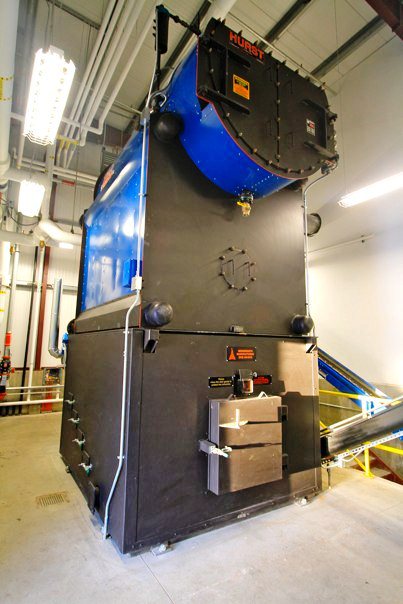Alaska Power Company customers in Tok and elsewhere in the Interior are unhappy that their electricity bills went up earlier this year. Some are frustrated that they’re being charged more partly because they’re conserving electricity – and generating it themselves.
It used to cost a lot of money to heat Tok School during the coldest months of winter.

( KUAC file photo)
“It was not uncommon to have bills for Tok School that were $30,000 a month,” says Scott MacManus, an administrator with Tok-based Alaska Gateway School District.
MacManus says those kinds of electricity bills convinced district officials they had to do something. So in 2010, they used an Alaska Energy Authority grant to build a renewable-energy system that burns wood chips to generate heat and electricity for Tok School.
This year, they invested in efficient lighting and put in place an energy-conservation program.
“We’ve undertaken a lot of efforts to save energy, because the cost of power is so high that it’s taking away from our kids our ability to provide a higher-quality education,” he said.
MacManus says those investments paid off: the biomass-fueled cogeneration system and energy-conservation effort have cut the school’s annual electricity bill about a third.
But he says those savings are being offset by Alaska Power Company raising its rates earlier this year, with another rate hike pending for early next year.
“We’ve dropped several hundred thousand dollars over the course of the last several years to do this,” he said. “…And their argument is, essentially, because we’re saving money, they have to charge more. Because we’re saving energy, they have to charge more.”
That’s part of the reason for the rate hike, says Mike Garrett. He’s the executive vice president of Alaska Power and Telephone, or AP&T, the parent company of Alaska Power Company.
Garrett concedes his company loses revenue when customers use less electricity – especially big customers, like the school district. It loses even more when big customers go away altogether, like the Coast Guard’s LORAN radar station, which shut down in 2010, and the Westmark Hotel, which closed last fall and hasn’t reopened for the summer tourist season.
“It’s a pretty simple math,” he said, “that if your costs go up, and the demand for the energy that you’re selling goes down, your rates are going to go up if you’re trying to recover those costs.”
Garrett says AP&T requested an 18 percent rate hike last year, its first such request since 2009, to close the gap in revenues created by falling demand and rising overhead costs.
“Maintaining lines. Maintaining generators. Going out and repairing when there’s a storm. Or costs associated with outages at 50 below. Those kinds of costs only get recovered whenever we do a rate case.”
The Regulatory Commission of Alaska granted AP&T an interim rate hike of 6 percent, effective last January, while it considers the company’s request for an 18 percent increase. It’ll announce its decision on that in February.
The commission also granted AP&T’s requests for cost of power adjustments, which enable utilities to charge customers more to cover the rising costs of fuel to generate electricity.
MacManus says he understand the economic realities that AP&T is facing. But he says the company needs to do more to adapt to changing conditions, like phasing out its oversized and inefficient diesel-fueled generators. And using more renewables to generate electricity. And encouraging, instead of discouraging, its customers to do the same.
“They have people who are willing to invest. People who would invest their own money into a power-system solution, as long as they were able to get something back out of it.”
Richard Kemper is one of those people. He’s set up a solar panel at his home in Tok, installed efficient lighting and he practices energy conservation.
Kemper doesn’t like the idea of paying more for electricity. But he believes it’s the price that we’ll all have to pay in order to transition into a sustainable-energy-fueled future.
“I think that we are in a transition period, from a time of cheap fossil-fuel power and not really caring about efficiency as far as energy goes. And it’s going to be a bumpy road.”
Kemper says homeowners should assume personal responsibility to solve the high-energy-cost problem by investing in an alternative-energy system. Because it’s the right thing to do – and because, eventually, it’ll pay off.
